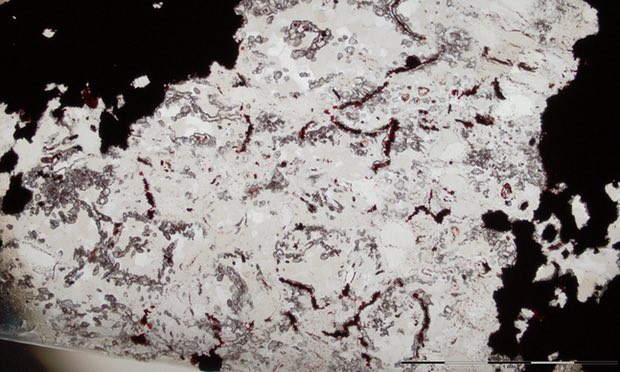@WFS,World Fossil Society,Riffin T Sajeev,Russel T Sajeev
WFS News: World’s oldest fossils found in Canada?
Scientists say they have found the world’s oldest fossils, thought to have formed between 3.77bn and 4.28bn years ago.
Comprised of tiny tubes and filaments made of an iron oxide known as haematite, the microfossils are believed to be the remains of bacteria that once thrived underwater around hydrothermal vents, relying on chemical reactions involving iron for their energy.

Rounded-shaped laminated iron-carbonate (orange) with white chert and black oxide and silicate layers in the Nuvvuagittuq Supracrustal Belt, Québec, Canada. This outcrop may have been part of a hydrothermal vent structure.Credit: D.Papineau
If correct, these fossils offer the oldest direct evidence for life on the planet. And that, the study’s authors say, offers insights into the origins of life on Earth.
“If these rocks do indeed turn out to be 4.28 [bn years old] then we are talking about the origins of life developing very soon after the oceans formed 4.4bn years ago,” said Matthew Dodd, the first author of the research from University College, London.
With iron-oxidising bacteria present even today, the findings, if correct, also highlight the success of such organisms. “They have been around for 3.8bn years at least,” said the lead author Dominic Papineau, also from UCL.
The team says the new discovery supports the idea that life emerged and diversified rapidly on Earth, complementing research reported last year that claimed to find evidence of microbe-produced structures, known as stromatolites, in Greenland rocks, which formed 3.7bn years ago.
However, like the oldest microfossils previously reported – samples from western Australia dating to about 3.46bn years ago – the new discovery is set to be the subject of hot debate.
The discovery of the structures, the authors add, highlights intriguing avenues for research to discover whether life existed elsewhere in the solar system, including Jupiter’s moon, Europa, and Mars, which once boasted oceans. “If we look at similarly old rocks [from Mars] and we can’t find evidence of life, then this certainly may point to the fact that Earth may be a very special exception and life might just have arisen on Earth,” said Dodd.
Published in the journal Nature by an international team of researchers, the new study focuses on rocks of the Nuvvuagittuq supra crustal belt in Quebec, Canada.

Filamentous microfossils from jasper rock discovered in a rock formation known as the Nuvvuagittuq supracrustal belt in Quebec, Canada. Photograph: Matthew Dodd/PA
The rocks are some of the oldest in the world and are believed to have formed around underwater hydrothermal vents – a theory backed up by various chemical signatures hinting at a submarine formation, as well as the presence of structures such as pillow basalts that are formed when lava encounters water.
The authors say scrutiny of very thin sections of the iron-containing quartz in which the fossils were found, together with an analysis of the minerals within them and microfossils themselves, suggests the haematite structures were not formed by physical processes alone.
Instead, the authors write, “the tubes and filaments are best explained as remains of iron-metabolising filamentous bacteria, and therefore represent the oldest life forms recognised on Earth.”
Up to half a millimetre in length and half the width of a human hair, the filaments have a range of forms, from loose coils to branched structures with some apparently linked together through a central knob of haematite – structures, said Dodd, that are common to microbes known to have lived near deep sea vents.
“The microfossils’ structures in themselves are almost identical, very similar, to microfossils and micro-organisms we see in similar hydrothermal vent settings today,” said Dodd. Minerals linked to biological matter were also found with the tubes and filaments, the authors note.
But not everyone is convinced by the new study, not least Frances Westall, an expert on ancient fossil bacteria at the French national centre for scientific research. “The thing that bothers me most about these structures is the fact that they all seem to be extremely oriented. They are parallel to each other and microbes don’t grow parallel to each other,” she said.
“What I am not saying is that there could not have been life at 3.8bn years ago,” Westall added. “But in rocks that have been so altered, like these have been, I think that morphological traces are unlikely to remain.”
Others, too, remain cautious, if more optimistic. David Emerson, a geomicrobiologist and expert in modern iron-oxidising bacteria at the Bigelow Laboratory for Ocean Sciences in the US said that the structures do not look like what would be expected from modern bacteria, but that he found it compelling that filaments are found in groups, suggesting a colony of microbes. But, he added, “I don’t think there is a smoking gun here that says this is clearly biological.”
Citation:Matthew S. Dodd, Dominic Papineau, Tor Grenne, John F. Slack, Martin Rittner, Franco Pirajno, Jonathan O’Neil, Crispin T. S. Little. Evidence for early life in Earth’s oldest hydrothermal vent precipitates. Nature, 2017; 543 (7643): 60 DOI: 10.1038/nature21377
Key: WFS,World Fossil Society,Riffin T Sajeev,Russel T Sajeev
@WFS,World Fossil Society,Riffin T Sajeev,Russel T Sajeev



 March 3rd, 2017
March 3rd, 2017  Riffin
Riffin  Posted in
Posted in  Tags:
Tags: 